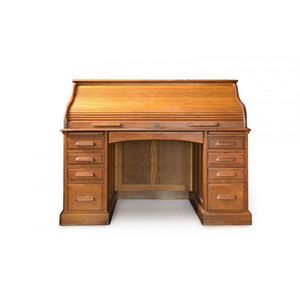Late 19th Century Australian Cedar Pedestal Desk
You must be a subscriber, and be logged in to view price and dealer details.
Subscribe Now to view actual auction price for this item
When you subscribe, you have the option of setting the currency in which to display prices to $Au, $US, $NZ or Stg.
- Plinth - The square or rectangular base of a piece of cabinet furniture, often ornamented with moulding. The plinth may be separate, as in some wardrobes or presses, and act as the support for the carcase. In a false plinth, the moulded boards may be attached directly to the piece. Furniture with a plinth base usually does not have separate feet. The term derives from architecture where it denotes the base of a column or statue.
- Pedestal - The columns that support many dining tables and most small occasional tables. They are usually turned, though octagonal-shaped pedestals were fashionable during the 1830s and 1840s.
- Tooled - Decoration of a leather surface, usually by stamping the surface with a heated punch or wheel containing foliate or geometric designs. In blind tooling the surface of the punch or wheel is in direct contact with the leather, while in gold tooling, a ribbon of gold leaf is placed between the punch or wheel and the leather, and once they have been applied, the excess gold is brushed off, leaving only the design.
- Blind Tooling / Blind Tooled - Blind tooling is a technique used in the decoration of leather goods such as book covers, belts, and wallets. It involves the use of specialized tools to impress designs and patterns onto the surface of the leather without the use of added colour.
The process involves the use of a variety of tools, including stamps, embossing tools, and finishing tools, which are used to create various textures and patterns on the leather surface. The tools are heated, and then pressed onto the leather, leaving an impression. The tools can be used to create designs that are simple or complex, with a variety of textures and patterns, including geometric shapes, florals, or scenes. The leather is then burnished to enhance the design and give it a smooth finish. - Pedestal Desk - A pedestal desk is a type of desk that consists of a large work surface supported by two pedestals or cabinets, one on either side. The pedestals are usually identical and contain drawers and cabinets for storage. The desk's design allows it to be placed in the centre of a room, as the back of the desk is usually finished with the same veneer as the front.
Pedestal desks were popular in the 18th and 19th centuries, and were usually made from high-quality wood, such as cedar, mahogany, walnut or oak, and were decorated with intricate carvings and other decorative details. They were used by businessmen, politicians, and other professionals, and were considered a symbol of status and success.
This item has been included into following indexes:
-
desks, material
- cedar, large 43
- cedar, small 43
- desks, period or age - Victorian 420
- desks, style or type - small antique pedestal 184
Visually similar items

An American oak, twin pedestal roll top desk c. 1920, height 119 cm, depth 77 cm, 152 cm

A cedar pedestal desk, Australian, circa 1890, 114 cm high, 145 cm wide, 75 cm deep

An early-19th century partners desk, height 77 cm, length 168 cm, depth 90 cm

Pair of Regency mahogany knife boxes the tilt top lid revealing extensive fitted interiors. Satinwood inlays. Ball feet. Note that one box is slightly taller than the other
